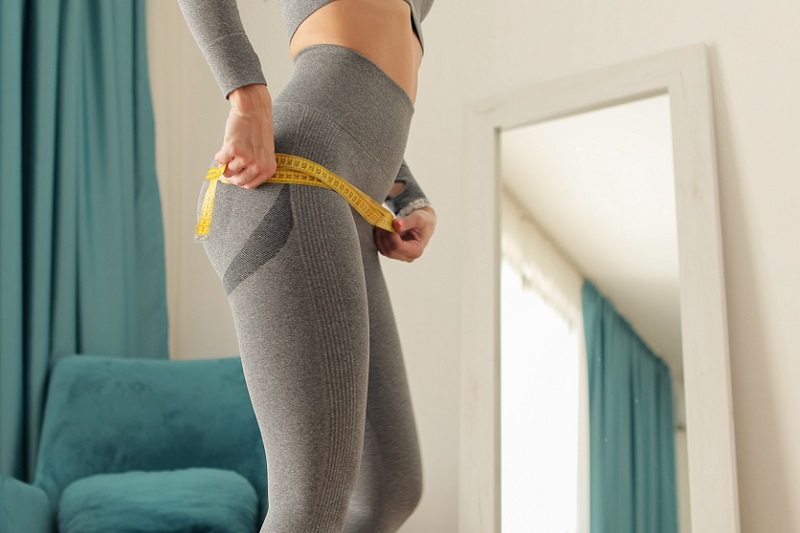What Are Hip Dips & Can You Get Rid of Them?

It seems like ever since the invention of photos in advertising, we (collectively) have been told there’s something wrong with our bodies. We’re too thin (or too flat). Too curvy (or overweight). We’re not tall enough… or too towering. Our thighs are like sticks… or too thick. One of the latest subjects we’re told to feel bad about is so-called hip dips. So, what are hip dips?
The term hip dips refers to the inward curve (or dip) below the hip bones and above the thighs. They’re also sometimes referred to as hip divots or violin hips. While a few years back, it wasn’t even a term, it now seems to be a growing concern, with an average of 18K searchers per month, according to Google. And people may now feel self-conscious or (have been shamed) by this latest “beauty standard” most of us never even knew existed.
What are Hip Dips?
Much like thigh gaps or lower back dimples (or lack thereof), “hip dips” are a social media-based “problematic” body part. Sadly, these types of body “preferences” are often highlighted, despite having nothing to do with how healthy, normal, or beautiful a body is. In fact, hip dips are simply due to anatomy.
So, if you’ve recently come across a reel or workout suggesting “how to get rid of hip dips,” stop right there. Depending on the way you’re built, hip dips can be more pronounced or nearly invisible to the naked eye. Most importantly, whether they’re subtle or more visible, they are completely normal and natural.
In other words, hip dips have nothing to do with how well you work out or how close you are to your ideal weight. Instead, they have everything to do with your natural bone structure. Working out harder (or choosing certain exercises) is neither necessary nor effective when it comes to the natural shape of your hips.
Why Some People Have More Noticeable Hip Dips
The natural indent in the hip is due to the space between the ilium (i.e., the largest bone in the pelvis) and your hip socket (i.e., where the top of the thigh bone or femur hits the hip bone). If you have more space in the bone structure—up or down or side to side—an indent can be more noticeable.
There’s nothing abnormal or wrong with your body if your hips dip more or less than the next person. It’s all down to your genetics and build—two things that are unchangeable.
How to Get Rid of Hip Dips
The short answer is, you can’t nor should you. They’re a healthy, natural part of your bone structure. While the amount of fat and muscles in your hips and glutes may impact how much they stand out, the effect is minimal as the base structure doesn’t change. Modifying their appearance isn’t like building shoulder caps (adding muscle) or revealing a six-pack (losing fat).
In fact, lowering your body fat may make your hip dips more pronounced as there’s less “flesh” to fill in the space. Yet spot reduction isn’t possible. So, where your body “holds” fat is not in your control. You can lose fat over your entire body yet still find your usual fat stores remain (though they may be smaller).
Instead of worrying about this made-up issue, focus on building strength, function, and shape in your lower body. The muscles surrounding the hips include the hip flexors, hip extensors, hip adductors, hip abductors, and lateral rotators.
Strong, healthy hips provide greater stability and mobility to help you move more effortlessly through your day and reduce the risk of injuries. Strong hips, for instance, can help protect your knees and reduce pain.
Some of the best exercises to support strong, healthy hips, glutes, and legs include:
- Squats of all varieties
- Side or lateral lunges (and curtsy lunges)
- Fire hydrants (side hip openers)
- Standing or lying side leg lifts (or hip abduction)
- Glute bridges (and especially banded glute bridges with abduction)
- Reverse lunges
What are Hip Dips? A Wrap-Up
Hip dips are just a new term for the way some bodies are built. You may be able to slightly modify their appearance by adding more fat or muscle, but you can’t get rid of them. And because they’re a natural part of your body and how you’re built, there’s no need to. Instead, focus on gaining strength, function, and flexibility in the lower body while embracing the beautiful body you have and all it does for you every day!



 7 Signs Your Body is Seriously Low on Collagen (not just wrinkles)
7 Signs Your Body is Seriously Low on Collagen (not just wrinkles) Health Expert: "Turmeric Doesn't Work (unless...)"
Health Expert: "Turmeric Doesn't Work (unless...)" 3 Warning Signs Your Probiotic Supplement is a Total Waste
3 Warning Signs Your Probiotic Supplement is a Total Waste

